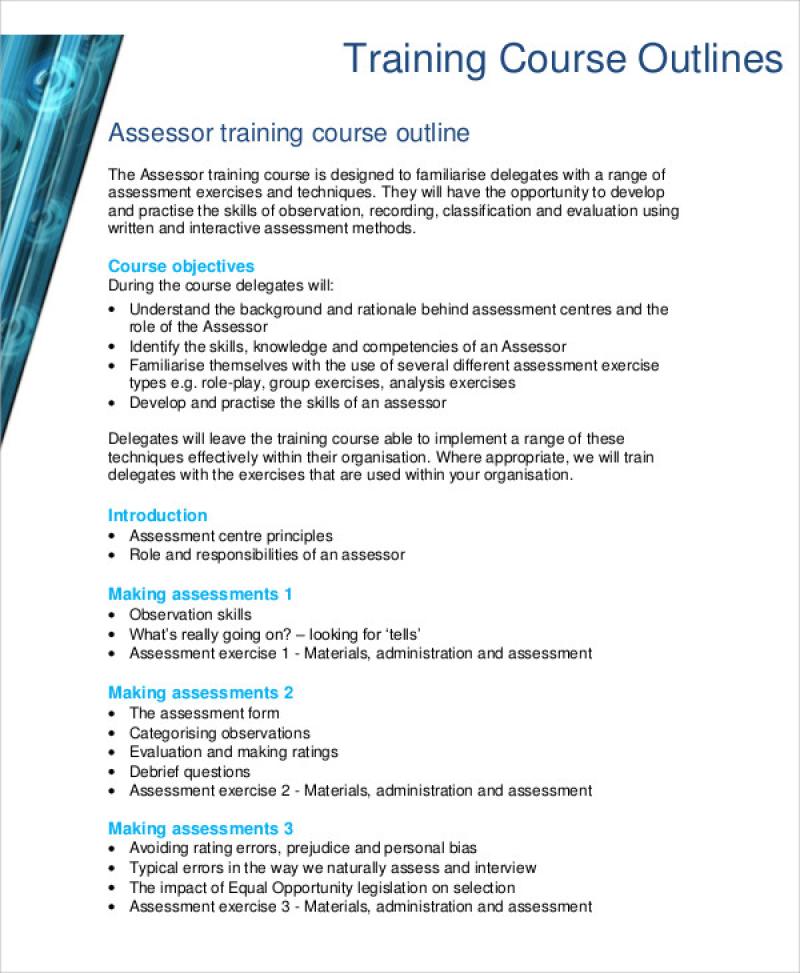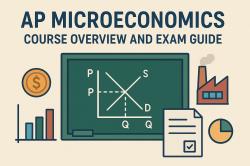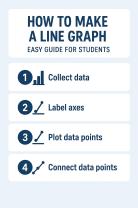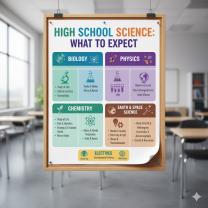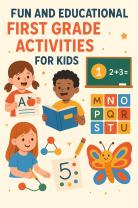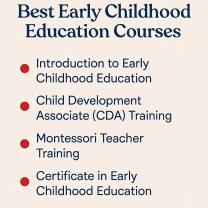What is the course outline sample format used for?
A course outline sample format is a template or structured guide used to organize and present the key elements of a course in a clear and consistent manner. It serves multiple purposes in education and training:
Uses of a Course Outline Sample Format
Curriculum Planning:
Helps instructors systematically plan what topics will be covered, in what order, and how much time is allocated to each topic.
Ensures alignment with learning objectives and standards.
Instructional Guide:
Acts as a roadmap for teachers, guiding lesson delivery and ensuring all important content is covered.
Provides consistency if multiple instructors teach the same course.
Student Reference:
Gives students an overview of the course structure, including topics, schedules, assignments, and assessment methods.
Helps students plan their learning and understand expectations.
Accreditation and Review:
Used by educational institutions to evaluate course quality and compliance with academic standards.
Serves as documentation during course approval or accreditation processes.
Assessment and Evaluation:
Clearly outlines how students will be assessed (exams, projects, participation), which helps ensure fairness and transparency.
Typical Components in a Course Outline Sample Format
Course Title and Code
Instructor Name and Contact Information
Course Description
Learning Objectives / Outcomes
Course Schedule / Weekly Topics
Required Materials / Textbooks
Assignments and Exams
Grading Policy
Class Policies
In short, a course outline sample format provides a structured framework for both teaching and learning, ensuring that everyone involved knows what to expect and how the course will progress.
Here's a comprehensive guide to understanding, creating, and utilizing course outlines to enhance both teaching and learning.
Purpose of a Course Outline Sample Format
A course outline, often called a syllabus, is more than just a schedule; it's a foundational document that serves multiple critical purposes for both instructors and students. A well-structured course outline sample format provides a clear, consistent blueprint for a course.
For Students:
Clarity and Expectations: It clearly communicates what students will learn, what is expected of them, and how their performance will be evaluated. This reduces ambiguity and helps students understand the "rules of the game."
Guidance and Planning: It provides a roadmap of the course, including topics, assignments, and deadlines, allowing students to plan their time effectively and manage their workload.
Resource Guide: It lists required texts, supplementary materials, and contact information, serving as a central reference point for all course-related needs.
Learning Aid: By outlining learning objectives and how they connect to assessments, it helps students focus their study efforts.
For Instructors:
Course Design and Cohesion: It forces instructors to thoughtfully structure their course, ensuring logical progression of topics, alignment of learning objectives with assessments, and overall coherence.
Accountability and Transparency: It documents the course content, policies, and grading criteria, providing transparency to students and administrators.
Time Management: Helps in pacing the course content and assignments throughout the semester.
Professionalism: A well-crafted outline reflects careful planning and professionalism, setting a positive tone for the course.
Reference for Future Iterations: It serves as a base document that can be revised and improved for future semesters.
Key Components of a Course Outline
While formats can vary, an effective course outline typically includes the following essential components:
Course Identification:
Course Title and Number
Semester/Term and Year
Instructor's Name, Contact Information (email, office hours, office location)
Teaching Assistant(s) Information (if applicable)
Department/Program
Course Description:
A brief overview of the course content and its relevance.
Prerequisites (if any).
Learning Objectives/Outcomes:
Clear, measurable statements describing what students should know or be able to do by the end of the course. Use action verbs (e.g., "analyze," "evaluate," "create," "explain").
Required Materials:
Textbooks (title, author, edition, ISBN, whether required or recommended).
Other readings (articles, websites, cases).
Software, tools, or supplies needed.
Course Structure/Schedule:
A weekly or topic-by-topic breakdown of lectures, discussions, and activities.
Associated readings for each session.
Key dates (e.g., midterms, project deadlines, holidays).
Assessment and Grading:
List of all assignments (e.g., exams, quizzes, papers, presentations, projects, participation).
A clear description of each assignment's requirements and learning purpose.
Weighting of each assessment component towards the final grade (e.g., Midterm 25%, Final Exam 30%, Assignments 30%, Participation 15%).
Grading scale (e.g., A=90-100%, B=80-89%).
Course Policies:
Attendance and Participation: Expectations and how they contribute to the grade.
Late Submissions: Policy on late assignments (e.g., penalty, grace period, no late work).
Academic Integrity: Clear statements on plagiarism, cheating, and the consequences.
Disability Services: Information on how students with disabilities can request accommodations.
Communication: How and when instructors will communicate with students (e.g., email, learning management system).
Respectful Learning Environment: Expectations for classroom conduct and interaction.
Important Dates/Calendar:
Relevant university dates (e.g., add/drop deadlines, withdrawal dates).
How to Customize a Course Outline for Your Class
Customizing your course outline makes it more relevant and engaging for your specific students and teaching style.
Tailor Learning Objectives: While the core content might be set, frame your learning objectives to reflect the specific skills and knowledge you want your students to develop. Consider their prior knowledge and the context of the course within their program.
Align with Your Teaching Philosophy: Let your teaching philosophy shine through. If you emphasize active learning, your outline should highlight discussions, group work, and interactive projects. If you focus on critical thinking, explicitly state how assignments will foster this.
Reflect Your Assessment Approach: Design assignments that directly measure the learning objectives. If an objective is to "analyze complex arguments," include an essay assignment that requires this, rather than just multiple-choice quizzes.
Consider Your Audience: Are your students first-year undergraduates, advanced graduate students, or working professionals? Adjust the tone, level of detail, and complexity of language accordingly. For example, first-year students might need more explicit guidance on academic policies.
Integrate Current Events/Disciplinary Trends: Incorporate up-to-date examples, recent research, or current events that relate to your course material to make it more relevant and dynamic.
Personalize the Tone: While professional, a friendly and approachable tone can make the syllabus less intimidating. You can include a short personal introduction or a statement about your enthusiasm for the subject.
Utilize Technology: If you're using a Learning Management System (LMS) like Canvas or Moodle, integrate the outline directly, linking to readings, external resources, and assignment submission portals.
Gather Feedback: After teaching the course, solicit feedback from students (formally or informally) about the clarity and usefulness of the syllabus to inform revisions for future iterations.
Keep it Dynamic (within reason): While a syllabus sets expectations, acknowledge that minor adjustments to the schedule or readings might be necessary. State a policy about how and when students will be informed of such changes.
Examples of Effective Course Outlines
Effective course outlines are clear, comprehensive, and engaging. While I can't provide a live interactive example here, I can describe characteristics that make them effective:
Clear, Concise Language: Avoid jargon where possible. Policies are stated plainly.
Strong Alignment: Learning objectives directly map to assessments and course activities.
Student-Centered Approach: Clearly explains why the course content and assignments are valuable to the student.
Visual Appeal: Uses headings, bullet points, and white space to make it easy to read and navigate. Some might use a table of contents.
Detailed Schedule: Provides specific dates for readings, topics, and assignments, reducing student confusion.
Comprehensive Policies: All expectations regarding grading, academic integrity, and support services are clearly articulated.
Resource Rich: Links to external resources, library guides, and university support services are included.
Accessible Format: Available in a format that is easy to access (e.g., PDF, online LMS page) and ideally meets accessibility standards for students with disabilities.
For a concrete example, imagine a "Introduction to Environmental Science" course outline. It would clearly list objectives like "Students will be able to identify major environmental challenges" and "Students will be able to evaluate solutions to climate change." Assessments would then include quizzes on challenges and a research paper evaluating a specific climate change solution.
Using Outlines to Improve Teaching and Learning
The course outline is not just a document; it's a tool that can actively enhance the teaching and learning experience:
For Teaching:
Staying on Track: The outline serves as a guide for the instructor to ensure all key topics are covered and deadlines are met, preventing last-minute rushes or missed content.
Facilitating Consistency: If multiple instructors teach the same course, a standardized outline can help ensure consistency in content and expectations.
Setting the Tone: A well-organized and thoughtful syllabus conveys professionalism and care, fostering a positive learning environment from day one.
Handling Student Questions: Many common student questions can be answered by simply referring them back to the syllabus, freeing up the instructor's time for more complex queries.
For Learning:
Self-Regulation: Students can use the outline to monitor their own progress, identify upcoming deadlines, and allocate study time effectively.
Targeted Study: By understanding the learning objectives and how they relate to assessments, students can focus their studying on the most important concepts and skills.
Understanding Expectations: A clear outline helps students understand what they need to do to succeed, reducing anxiety and allowing them to focus on learning rather than guessing requirements.
Advocacy and Fairness: In cases of disagreement or confusion, the syllabus acts as a mutually agreed-upon contract, providing a basis for discussion and ensuring fairness.
Connecting the Dots: When students see how individual topics, readings, and assignments contribute to broader learning objectives, they gain a deeper understanding of the course's overall purpose and the relevance of the material.
By thoughtfully crafting and consistently referring to a course outline, instructors can create a more transparent, organized, and effective learning experience for all.
